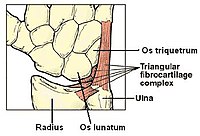
Photo from wikipedia
Background: Symptomatic ulnar styloid non-union can be treated by excision of the ulnar styloid fragment. For combined triangular fibrocartilage complex (TFCC) tears, several repair techniques such as arthroscopic repair, open… Click to show full abstract
Background: Symptomatic ulnar styloid non-union can be treated by excision of the ulnar styloid fragment. For combined triangular fibrocartilage complex (TFCC) tears, several repair techniques such as arthroscopic repair, open repair to the fracture site or reconstruction using a tendon graft have been introduced. This study reports the technique and outcomes of open foveal repair of the TFCC with excision of the ulnar styloid fragment in patients with symptomatic ulnar styloid non-union and distal radioulnar joint (DRUJ) instability. Methods: Consecutive patients with symptomatic ulnar styloid non-union with TFCC tears and DRUJ instability who underwent excision of the ulnar styloid fragment and open foveal repair of the TFCC were retrospectively reviewed. After excising the ulnar styloid fragment, a capsular window was created between the triquetrum and TFCC, followed by attaching the TFCC to the fovea using three sutures through a bone tunnel from the ulnar cortex to the fovea. Additional ulnar shortening osteotomies were performed in patients with positive ulnar variance and ulnar impaction test. The outcomes were evaluated in terms of DRUJ stability and the Quick Disabilities of the Arm, Shoulder and Hand (DASH) scores. Results: In total, 21 patients with a mean age of 40 were enrolled in the study. All patients demonstrated DRUJ stability at a mean follow-up duration of 14 months. The mean Quick DASH score significantly improved from 18.9 ± 11.7 to 2.5 ± 4.1 (p < 0.05). Eleven patients underwent combined ulnar shortening osteotomies, and no difference in the Quick DASH score was found between patients who underwent ulnar shortening osteotomy and those who did not. Conclusions: This study demonstrates that open foveal repair of the TFCC with ulnar styloid fragment excision is an effective strategy to surgically treat patients with symptomatic ulnar styloid non-union with TFCC tear and DRUJ instability. Level of Evidence: Level III (Therapeutic).
Journal Title: The journal of hand surgery Asian-Pacific volume
Year Published: 2022
Link to full text (if available)
Share on Social Media: Sign Up to like & get
recommendations!